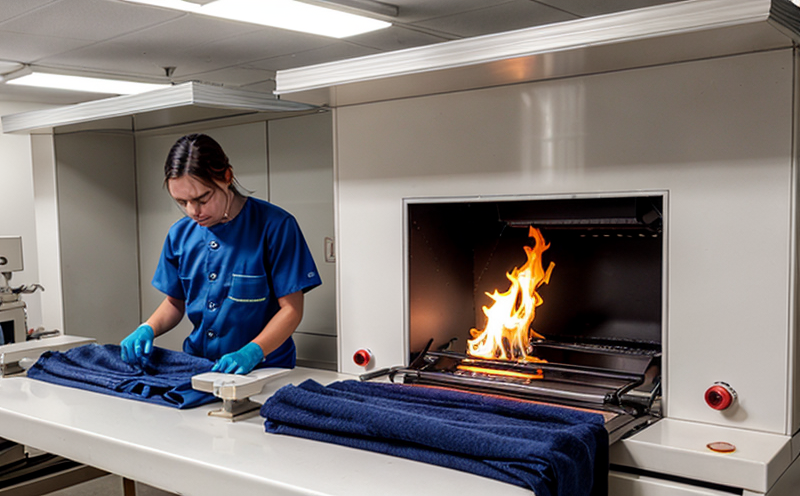Heat Release Rate Assessment of Clothing Fabrics
The heat release rate (HRR) assessment is a critical step in ensuring textile and apparel products meet fire safety standards. This test evaluates the flammability of clothing fabrics by measuring how quickly they ignite, their burning behavior, and the amount of heat released during combustion. Understanding HRR is vital for quality managers, compliance officers, R&D engineers, and procurement teams who are responsible for developing safe and reliable textile products.
The HRR test provides insights into a fabric’s resistance to ignition and its potential flame spread characteristics. It helps manufacturers identify materials that meet stringent flammability requirements, ensuring that the final product is not only aesthetically pleasing but also safe for consumers. This service plays a pivotal role in safeguarding lives by preventing accidental fires caused by improperly designed or manufactured clothing.
The testing process involves subjecting fabric specimens to controlled burning conditions and measuring the heat release rate over time using specialized equipment such as a Cone Calorimeter. Compliance with international standards like ISO 13542, ASTM E672, and EN 13917 is essential for ensuring accurate results and meeting regulatory requirements.
During testing, it’s important to consider the following factors that can influence HRR:
- Type of fabric (natural vs synthetic fibers)
- Finishing treatments applied to the fabric
- Construction details such as weave patterns and thickness
- Environmental conditions during testing, including temperature and humidity levels
The HRR test not only helps in assessing the flammability of individual fabrics but also provides valuable data for improving product design. By understanding how different materials behave under fire exposure, manufacturers can make informed decisions about material selection and processing techniques.
For quality managers, this service offers a clear path to ensuring that products comply with relevant regulations and industry best practices. Compliance officers benefit from having objective data to verify adherence to standards, while R&D engineers use the results to innovate safer materials and manufacturing processes. Procurement teams can leverage these insights to source high-quality fabrics that meet rigorous safety criteria.
The HRR test is particularly important in sectors where fire risk is higher due to the nature of the products or environments. For instance, firemen’s clothing, children's pajamas, and workwear for hazardous industries all require stringent flammability testing to ensure they can withstand unexpected ignition events without posing undue risks.
Understanding HRR also helps in evaluating the effectiveness of various flame retardant treatments. These treatments are often applied to textiles to reduce their flammability, but their success depends on how well they perform under actual fire conditions. The HRR test provides a standardized way to measure this performance, allowing for continuous improvement and optimization of these treatments.
In conclusion, the heat release rate assessment is an indispensable tool in ensuring textile and apparel products meet fire safety standards. By providing detailed insights into fabric flammability, this service supports the development of safer, more reliable clothing that can protect consumers in challenging situations.
Industry Applications
| Industry Segment | Description of Application |
|---|---|
| Fashion & Apparel | Evaluating the safety and compliance of textiles used in clothing, especially for children's wear. |
| Hazardous Industry Workwear | Ensuring protective clothing meets stringent fire safety standards to protect workers in high-risk environments. |
| Fire Protection Clothing | Verifying the performance of firefighting garments under simulated burning conditions. |
| Automotive Interiors | Assessing the flame resistance and heat release rate of interior fabrics to prevent fire hazards in vehicles. |
The HRR assessment is widely used across these industries, ensuring that textiles are not only aesthetically pleasing but also safe for use. This testing method plays a crucial role in preventing accidents and protecting lives by identifying potential hazards early in the product development process.
Why Choose This Test
- Meets international fire safety standards such as ISO, ASTM, and EN.
- Provides objective data for compliance verification.
- Promotes the use of safe materials in product design.
- Offers insights into flame retardant treatment effectiveness.
- Supports continuous improvement of fire safety standards.
- Aids in regulatory compliance and market entry.
- Ensures product reliability and performance under real-world conditions.
The HRR assessment is a vital tool for manufacturers looking to produce safe, reliable products that meet both legal requirements and consumer expectations. By choosing this test, companies can enhance their reputation as industry leaders in fire safety, ensuring they remain competitive in the market.
Competitive Advantage and Market Impact
The heat release rate assessment of clothing fabrics provides a significant competitive advantage by helping manufacturers differentiate their products through superior safety features. Compliance with international standards not only ensures legal compliance but also builds trust among consumers, retailers, and regulatory bodies.
By identifying and addressing potential fire hazards early in the product lifecycle, companies can avoid costly recalls and negative publicity associated with unsafe products. This proactive approach to quality control enhances brand reputation and customer loyalty, contributing to long-term market success.
The HRR assessment also plays a role in reducing insurance premiums for businesses that demonstrate adherence to strict safety standards. In sectors where fire risks are particularly high, such as hazardous industries or public venues, this service can help mitigate the costs associated with potential accidents and injuries.
Moreover, by continuously refining their testing protocols based on HRR results, manufacturers can stay ahead of evolving regulatory requirements and consumer preferences for safer products. This commitment to innovation and safety can set companies apart from competitors who may not prioritize these aspects as thoroughly.
In conclusion, the heat release rate assessment is a strategic investment that offers tangible benefits in terms of product quality, brand reputation, market competitiveness, and overall business success. By choosing this test, manufacturers can position themselves as leaders in fire safety, ensuring they remain resilient in an ever-changing market landscape.





